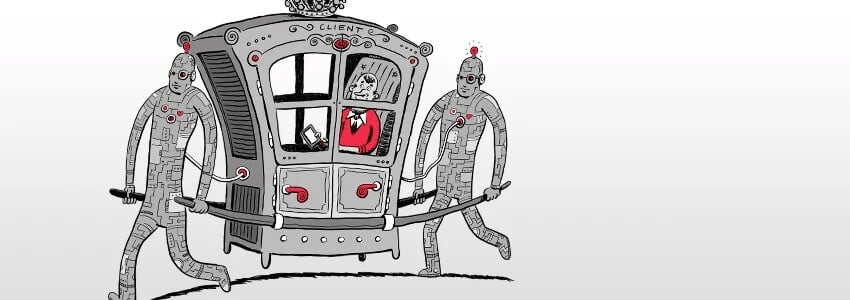You do not have to see a fortune teller to anticipate customers' desires and needs. Neither is a magic wand required to make customers' wishes come true. All you need to give your customers a rich, relevant and homogeneous customer journey is a suitable technological solution. But how to pick the right one? To generate and retain clients, companies have to offer a great customer experience. The customer experience describes the complete customer life cycle: it starts with the brand message and continues with every interaction between client and organization. And it does not end with the purchase of a product, but extends beyond the warranty claim to future purchases. The process of becoming aware of an offer to actually claiming it is called customer journey.
Businesses looking to optimize customer journeys have to know the various personas that make up their customer base and deliver content that matches each persona at each touch point. Moreover, taken together, all touch points have to constitute a homogenous customer journey. The further users move along the customer journey, the more information is a business going to learn about them and the more specific can it approach them with offers. That is, if your use the right technology to actually gather, analyze and use user data. The basic principle for optimizing the customer journey is to understand that this is a user-centric approach to marketing. The objective is to create a win-win situation for both customer and organization.
Whereas there is little room for interpretation in theory, the implementation of customer experience marketing offers many alternatives. These alternatives are by and large related to the available software providers. Before a decision on a specific software is made, businesses should consider if an all-in-one solution or an individual, customized solution helps them the best.
Strategy 1: Customized solution
Requirements change and so do the various technologies. This means that businesses continually develop their business solutions by upgrading them or by adding new components. What we are trying to say here is that companies may assemble the various components necessary to optimize the customer journey themselves (or get help doing so). Some of the components are probably already there: content management system (CMS) and customer relationship management (CRM) should already be in place.
The CRM is used to manage existing clients and the CMS is used to mange the website. These two tools do not suffice to optimize the customer journey. In order to deliver relevant content to the right people at the right moment, you have to know your clients and assign them personas. In order to get the data necessary for this, you require analysis tools that help you to monitor and evaluate the online behavior of online users on your website and landing pages. Moreover, a customer journey takes place across various channels. You need tools for every one of those, i.e. newsletter and social media marketing applications.
Still, two essential questions need to be answered: Where do you store the data and what is the main interface for your customer experience marketing? Many companies have identified the CRM as the latter.
The CRM is supposed to put the client at the center of your attention. However, often only the client's progress along the customer journey is really the focus of the CRM. Having a 360 degree perspective on a client is about more than that. In reality, the CRM is also about internal process (marketing and sales workflows). This approach does not really track users' needs, but most importantly: the CRM-centric approach to customer experience marketing completely ignores users that are not yet registered customers. But those are the ones you want to become leads!
A customer-oriented, customized solutions requires a dashboard that unifies the various components that are necessary to create a rich, relevant and homogeneous customer journey.
W4's advise: A customized solution could cause added costs in the short term. It also takes some effort. But it is worth the investment as you receive a solution that exactly meets your needs. However, using several components has its obvious pitfalls and will not benefit your company significantly if you do not create a central interface. This is the only way you can manage all marketing activities centrally. You profit from more straight-forward workflows and never lose sight of the progress you make. Furthermore, you ensure a homogeneous customer journey and that is what really matters here.
Strategy 2: All-in-one solution
While the development of a customized solution can take some time and be complex, an all-in-one solution can be had with less effort. An all-in-one solution offers all tools that are necessary to optimize the customer journey from a single provider. There are solutions for various business sizes. A small company for example will look for a solution that features email, social media and CRM. An enterprise will require additional features like analytics, SEO, blogs and APIs.
No matter the size of the solution, it still has to be implemented, which means that even these solutions cannot be had without any effort. Moreover, while some basic solution does not cost a lot of money, the more advanced products usually require a bigger financial investment.
W4's advice: Companies that do not really have the required components to optimize the customer experience or are dissatisfied with the tools they have should consider an all-in-one solution like Sitecore. The software features CMS, CRM, product information system, marketing automation and predictive analytics. These are the essential tools needed to give customers a great experience as they allow businesses to bring the right content in front of the right users at the right time thanks to its predictive analytics and marketing automation features. With these two tools, the software can deliver content dynamically. Still, companies should think about what they really need and if the available all-in-one products fit their individual needs.
The benefits of customer experience technology:
✓ Manage all touch points with one solution
✓ Put clients' needs front and center
✓ Mange your brand image more effectively
✓ Increase conversion rates
Our services
Whether it is an all-in-one or a customized solution: the decision for one or the other customer experience solution has to be thoroughly considered. We gladly advise you on the available alternatives and can organize the professional implementation of your choice.









